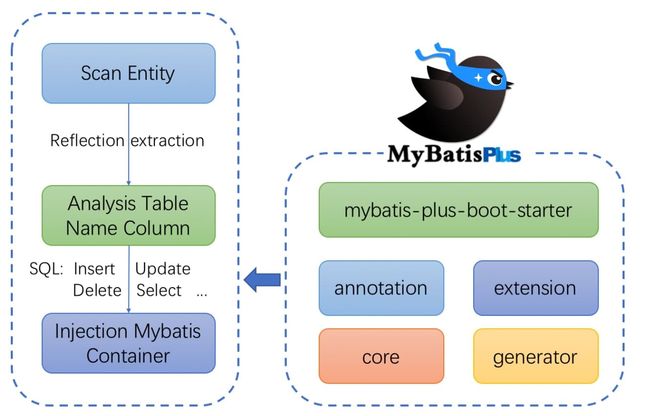MyBatis-Plus 系列
目录:
一、 Spring Boot 整合 MyBatis Plus
二、MyBatisPlus 多数据源配置
三、MybatisPlus —注解汇总
四、MyBatis Plus—CRUD 接口
五、MyBatis-Plus 条件构造器
六、MyBatis-Plus 代码生成器
MyBatis-Plus (opens new window)(简称 MP)是一个 MyBatis (opens new window)的增强工具,在 MyBatis 的基础上只做增强不做改变,为简化开发、提高效率而生。
一、特性
- 无侵入:只做增强不做改变,引入它不会对现有工程产生影响,如丝般顺滑
- 损耗小:启动即会自动注入基本 CURD,性能基本无损耗,直接面向对象操作
- 强大的 CRUD 操作:内置通用 Mapper、通用 Service,仅仅通过少量配置即可实现单表大部分 CRUD 操作,更有强大的条件构造器,满足各类使用需求
- 支持 Lambda 形式调用:通过 Lambda 表达式,方便的编写各类查询条件,无需再担心字段写错
- 支持主键自动生成:支持多达 4 种主键策略(内含分布式唯一 ID 生成器 - Sequence),可自由配置,完美解决主键问题
- 支持 ActiveRecord 模式:支持 ActiveRecord 形式调用,实体类只需继承 Model 类即可进行强大的 CRUD 操作
- 支持自定义全局通用操作:支持全局通用方法注入( Write once, use anywhere )
- 内置代码生成器:采用代码或者 Maven 插件可快速生成 Mapper 、 Model 、 Service 、 Controller 层代码,支持模板引擎,更有超多自定义配置等您来使用
- 内置分页插件:基于 MyBatis 物理分页,开发者无需关心具体操作,配置好插件之后,写分页等同于普通 List 查询
- 分页插件支持多种数据库:支持 MySQL、MariaDB、Oracle、DB2、H2、HSQL、SQLite、Postgre、SQLServer 等多种数据库
- 内置性能分析插件:可输出 SQL 语句以及其执行时间,建议开发测试时启用该功能,能快速揪出慢查询
- 内置全局拦截插件:提供全表 delete 、 update 操作智能分析阻断,也可自定义拦截规则,预防误操作
二、支持数据库
任何能使用
MyBatis进行 CRUD, 并且支持标准 SQL 的数据库,具体支持情况如下,如果不在下列表查看分页部分教程 PR 您的支持。
-
MySQL,Oracle,DB2,H2,HSQL,SQLite,PostgreSQL,SQLServer,Phoenix,Gauss ,ClickHouse,Sybase,OceanBase,Firebird,Cubrid,Goldilocks,csiidb,informix,TDengine,redshift
-
达梦数据库,虚谷数据库,人大金仓数据库,南大通用(华库)数据库,南大通用数据库,神通数据库,瀚高数据库,优炫数据库,星瑞格数据库
三、框架结构
四、添加依赖
引入 Spring Boot Starter 父工程:
org.springframework.boot
spring-boot-starter-parent
2.5+ 版本
引入 spring-boot-starter、spring-boot-starter-test、mybatis-plus-boot-starter、h2 依赖:
org.springframework.boot
spring-boot-starter
org.springframework.boot
spring-boot-starter-test
test
com.baomidou
mybatis-plus-boot-starter
最新版本
com.h2database
h2
runtime
五、配置
在 application.yml 配置文件中添加 H2 数据库的相关配置:
# DataSource Config
spring:
datasource:
driver-class-name: org.h2.Driver
username: root
password: test
sql:
init:
schema-locations: classpath:db/schema-h2.sql
data-locations: classpath:db/data-h2.sql
在 Spring Boot 启动类中添加 @MapperScan 注解,扫描 Mapper 文件夹:
@SpringBootApplication
@MapperScan("com.baomidou.mybatisplus.samples.quickstart.mapper")
public class Application {
public static void main(String[] args) {
SpringApplication.run(Application.class, args);
}
}
六、编码
编写实体类 User.java(此处使用了 Lombok (opens new window)简化代码)
@Data
@TableName("`user`")
public class User {
private Long id;
private String name;
private Integer age;
private String email;
}
编写 Mapper 包下的 UserMapper接口
public interface UserMapper extends BaseMapper {
}
七、开始使用
添加测试类,进行功能测试:
@SpringBootTest
public class SampleTest {
@Autowired
private UserMapper userMapper;
@Test
public void testSelect() {
System.out.println(("----- selectAll method test ------"));
List userList = userMapper.selectList(null);
Assert.isTrue(5 == userList.size(), "");
userList.forEach(System.out::println);
}
}
提示
UserMapper 中的
selectList()方法的参数为 MP 内置的条件封装器Wrapper,所以不填写就是无任何条件
控制台输出:
User(id=1, name=Jone, age=18, [email protected])
User(id=2, name=Jack, age=20, [email protected])
User(id=3, name=Tom, age=28, [email protected])
User(id=4, name=Sandy, age=21, [email protected])
User(id=5, name=Billie, age=24, [email protected])
